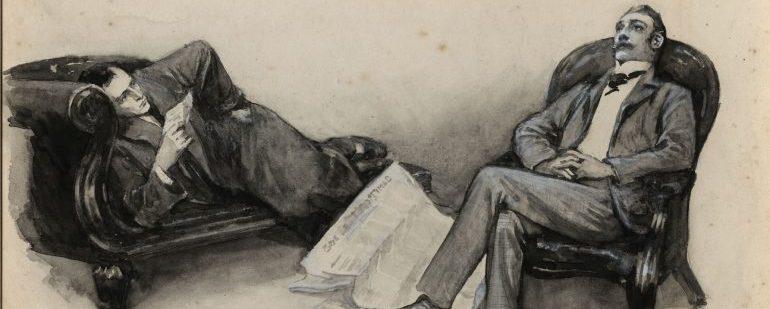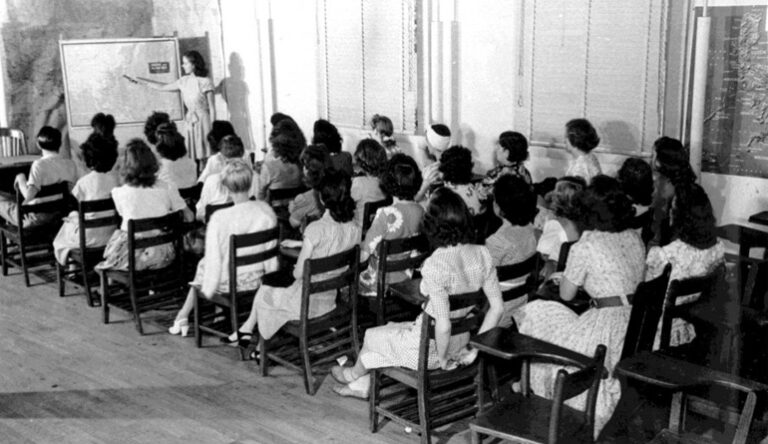Big Picture, Small Picture: Context for Arthur Conan Doyle’s “The Red-Headed League”

This blog series, Big Picture, Small Picture, provides a contextual collage for a chosen piece of literature. The information here is culled from newspapers, newsreels, periodicals, and other primary sources from the date of the text’s original publication.
The man is nothing; the work is everything.
—Gustave Flaubert
Summer, 1891. Crime and mysteries abound in southern England. On the evening of August 8th, a “perfectly sober” woman is seen walking home on a stone road in Epsom. Early the next morning she is found dead in the street, her throat cut, sending out gruesome echoes of Jack the Ripper’s escapades just three summers ago. Rumors of a group of young assailants spread, but the mystery deepens when the coroner’s report claims the wounds are self-inflicted. Detectives are stymied.
The next night, just east of Epsom, a different mystery unfurls on the shores of Dover. Two Light Infantrymen stationed at the docks steal a boat and set out to sea. The following morning the boat is picked up by a patrol, but with only one soldier and one oar. The man hops from one account of his companion’s disappearance to another, at first claiming he dropped his fellow soldier at a sandy shore, but none exist within miles. Next, he says he deposited his friend on a passing steamer. Finally, he asserts that when the second oar fell in the water, the soldier went down after it, never to resurface. The detectives on the case decide to hold him for further questioning.
Local law enforcement employs increasingly creative tactics to confront the rising tide of ne’er-do-wells. To investigate reports of a man performing lewd acts in his window on Marlborough street, a police officer dons rouge, eye-liner, and a dress and lingers in a window across the block. True to the allegations, the suspect presents himself in the window, nude and indecent. As he is arrested, the prisoner laments, “Golly, what a nuisance!”
The August issue of The Strand Magazine, a fledgling publication boasting to slake the public’s thirst for intrigue and adventure, hits the shelves in London. The issue includes Arthur Conan Doyle’s fourth Sherlock Holmes story, “The Red-Headed League,” in which the hawk-nosed detective grapples with a “three-pipe problem”—that of the baffling and sudden dissolution of an enigmatic league of red-headed gentlemen. Holmes throws himself into the case with characteristic erudition, while Dr. Watson gamely follows and takes notes. At the mystery’s core, Holmes suspects that a certain brilliant confidence man has designs on the contents of a bank’s vault.
Real life con men and thieves work their subterfuges in London. A man claiming to be a detective regales an old widow with stories of past investigations, all the while coaxing over 200 pounds from her purse and gaining the hand of her daughter in marriage. When the sham detective is finally arrested, his life-long criminal history of violence and deceit is revealed.
Things are no better across the Atlantic; a newspaper writer in New Jersey declares that Sunday, August 16 is “a great day for thieves.” He bemoans the degradation of a once-family-friendly German sausage festival: despite the “rivers of lager beer and the miles of frankfurter,” the atmosphere at the event is marred by the hordes of “crooks, thieves, blacklegs and confidence men who are at present fortunate enough to be out of jail.” The police, helpless against the criminal deluge, stand idly by.
Licensed private detectives advertise their wares in the back pages of London’s newspapers, promising to be an ally in the war against wrong-doings. Abbot’s Detective Offices conduct their investigations with “secrecy and dispatch.” With 28 years of experience, “no one has received so many rewards and commendations from her majesty’s judges” as W. Chamberlain and his squadron of assistants. Detective Justin Chevasse is an “expert in confidential investigations for the aristocracy.” For the average working citizen, Lennard’s is the “surest, safest, and cheapest private detective office.”
The Strand will publish four more Sherlock Holmes stories in 1891, including the classics, “A Case of Identity,” and “The Five Orange Pips,” bolstering the renown of both the publication and Doyle himself. But the days of the printed word’s monopoly on entertainment are numbered. On August 24th, Thomas Edison patents his motion picture camera. Less than a year later, in June of 1892, Basil Rathbone is born; the young actor will perform Shakespeare on London stages in such roles as Cassius and, his favorite, Romeo, but will forever be known for his portrayal of Sherlock Holmes in fourteen Hollywood films.
In the final scene of the 1943 film, Sherlock Holmes Faces Death, released during the throes of WWII, Rathbone-as-Holmes pontificates on the moral duties of the individual in society: “There’s a new spirit abroad in the land. The old days of grab and greed are on their way out…The time is coming, Watson, when we cannot fill our bellies in comfort while the other fellow goes hungry, or sleep in warm beds while others shiver in the cold…And God willing, we’ll live to see that day, Watson.”
But Doyle’s vision of Holmes in 1891 seems far less civic-minded in his strivings for justice. What motivates him is more personal and therapeutic; diversions like the case of the Red-Headed League temporarily save him from an adversary more formidable than even Professor Moriarty: the creeping ennui of everyday life.
In the final lines of “The Red-Headed League,” Holmes confesses to Watson, “my life is spent in one long effort to escape from the commonplaces of existence. These little problems help me to do so.”


